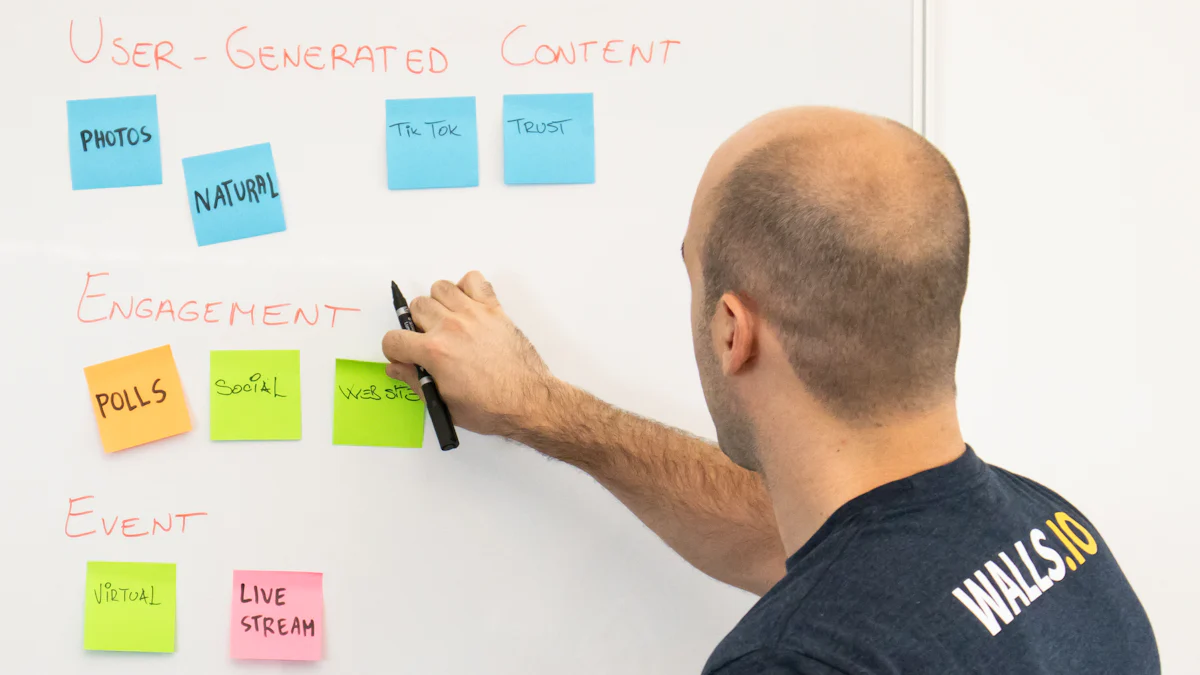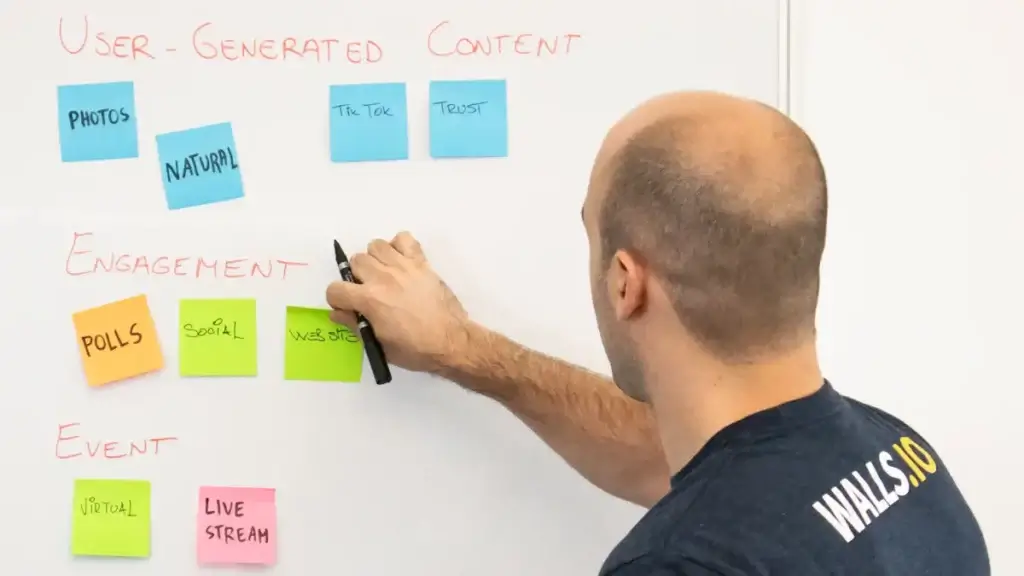
Lead generation or how to generate qualified leads
Lead generation is a crucial process for any business looking to grow. A qualified lead, that is to say a prospect who has demonstrated a clear interest in your products or services, increases the chances of conversion and optimizes your return on investment (ROI). Businesses that focus on lead quality often report increased revenue and improved sales efficiency.
Concrete examples and case studies:
-
Example Case Study: HubSpot
HubSpot, a marketing and sales platform, implemented a qualified lead generation strategy by combining educational content and free tools (like ROI calculators and site analytics tools) . This strategy allowed them to increase their qualified leads by 30% in the space of six months. The case study shows that 78% of leads converted into customers interacted with their educational content beforehand.Reference : HubSpot case study .
-
Case Study: Marketo
Marketo, a marketing automation platform, used targeted nurturing campaigns to requalify cold leads. By providing content tailored to user behavior (like case studies for lukewarm leads and product demos for warm leads), the company was able to reduce the average sales cycle length by 40%.Reference : Marketo Case Study .
Expert testimonials:
John Smith, digital marketing expert, says :
"A focus on lead qualification is crucial for any business that wants to grow sustainably. Nurturing campaigns based on well-defined segments not only increase conversion rates, but also to retain customers in the long term. Strategies such as retargeting or ABM (Account-Based Marketing) are essential to maximize efficiency.
Building confidence with statistics and references:
-
Key Lead Generation Statistics :
-
According to a study by DemandGen , leads nurtured with nurturing campaigns generate 50% more sales than non-nurtured leads and cost 33% less.
-
Forrester reports that companies that excel at lead nurturing achieve a 47% higher conversion rate.
Sources : Demandgen Report , Forrester Research .
-
Recommended strategies for generating qualified leads:
-
Take a Content-Centric Approach
One of the best ways to generate qualified leads is to produce relevant content that attracts and educates your target audience. For example, LinkedIn reports that companies that publish quality articles and reports see a 45% increase in online engagement, generating more qualified leads.Source : Linkedin Marketing Solutions .
-
Setting up nurturing campaigns
To turn lukewarm leads into hot leads, it is crucial to use nurturing strategies, such as email marketing and marketing automation. According to HubSpot , businesses that use personalized email sequences see an 80% higher open rate and 60% higher click-through rate compared to generic campaigns.Source : HubSpot Research .
The importance of qualified leads in the conversion process:
A qualified lead reduces prospecting costs while increasing conversion rates. Salesforce study found that 79% of qualified leads end up becoming customers, compared to just 33% of unqualified leads. This shows the direct impact of qualified leads on the company's turnover and profitability.
Source : Salesforce Research .
Understanding Lead Generation
What are BtoB lead leads for businesses?
A lead represents a potential contact interested in your products or services. You need to understand the different types of leads to better qualify them.
Different types of leads
-
Cold Leads : These prospects have little or no initial interest in your product or service. They have not yet expressed a clear need and require intensive nurturing to be made aware of your offers. The strategy to adopt is to establish a relationship of trust and provide them with educational content to pique their interest over time.
Case in point : A cold lead could be a business that was added to your database through an automated prospecting campaign but has never interacted with your content before. For example, a professional in the construction industry who received an initial email from you but has not yet clicked on a link or shown interest.
Case study : According to a study by Marketing Sherpa, 79% of leads captured via a campaign do not convert into immediate sales, which shows the importance of cold lead nurturing. One SaaS company, for example, used a 6-month nurturing strategy, combining educational emails and case studies, to turn 15% of their cold leads into customers.
Approach : For this type of lead, it is essential to create a relationship of trust. Use educational content, such as blog articles or ebooks, to educate the prospect about your solutions and convince them of the usefulness of your product or service. This allows you to gradually move from a cold lead to a lukewarm lead.
-
Lukewarm Leads : These leads have shown moderate interest in your product or service, such as downloading a white paper or subscribing to a newsletter. They are more receptive to receiving additional information. Nurturing here involves providing more targeted and in-depth content, while encouraging more engaging actions, such as a product demo or free consultation.
Concrete example : Let's say an SME downloads a white paper from your website or registers for a webinar. She is showing interest, but has not yet expressed an intention to purchase. The lead is open to receiving more information about your product or service, but they are not yet ready to purchase.
Case Study : A digital marketing company used newsletters to turn lukewarm leads into hot leads. By sending targeted emails containing case studies and customer testimonials, she was able to increase her conversion rate by 25%. Additionally, according to a HubSpot study, companies that excel at nurturing generate 50% more qualified leads at 33% lower cost.
Approach : Lukewarm leads require a more active approach. Provide them with more in-depth content and engaging offers, like product demos, free consultations, or free trials. This helps them move forward in their thinking and get closer to the purchasing decision.
-
Warm Leads : These prospects are already highly interested and ready to take action. They have often interacted with your brand several times and are in the final evaluation phase. The objective here is to convert them into customers with personalized offers, promotions or direct calls to action (making an appointment, personalized quote).
Concrete example : A warm lead could be a company that has visited your product pages several times, requested a quote or a product demo. This lead is in the final decision phase and is ready to take action, especially if they receive a personalized offer.
Case study : A B2B software provider discovered that by personalizing its offers for hot leads (for example, by offering a preferential rate for immediate subscription), it was able to increase its conversion rate by 40%. According to a study by InsideSales, leads followed up within 5 minutes of expressing interest are 9 times more likely to convert.
Approach : Warm leads are ready to be converted into customers. It is crucial to act quickly and provide specific and attractive offers. Use direct calls to action, such as an immediate appointment, a product demo or a special offer to encourage them to buy quickly.
1. Nurturing tactics for cold leads
Cold leads have little or no initial interest in your products or services. The key is to raise awareness and arouse their interest gradually.
-
Concrete example : A B2B company specializing in software developed a series of informative newsletters to educate its cold leads. These emails included articles on industry trends, case studies illustrating how other companies were using their solution, and explainer videos on the benefits of automation.
Nurturing tactics :
-
Educational content : Send educational blog posts, ebooks, white papers, or videos to educate cold leads on topics related to their business challenges and your solutions.
-
Awareness campaigns : Offer free webinars or online training sessions. These events allow you to demonstrate your expertise and capture the attention of prospects while providing value without commitment.
-
Social media : Use ads on LinkedIn or Facebook to retarget these leads with educational content. They need to understand that your product can solve their problems before they even think about purchasing.
-
Lead Scoring : Implement a scoring system to identify when these cold leads begin to engage more actively with your content, signaling that they are becoming lukewarm.
2. Nurturing tactics for lukewarm leads
Lukewarm leads have already shown moderate interest, such as subscribing to a newsletter or downloading an ebook. They are receptive to additional information and ready to be more actively engaged.
-
Case in point : A consulting firm used automated email series to deliver industry case studies and customer stories to its lukewarm leads. The goal was to show concrete results achieved by similar companies and encourage prospects to request a free consultation.
Nurturing tactics :
-
Case studies and testimonials : Provide more targeted content, such as case studies and customer testimonials showing measurable results. Prospects want to see proof that your product or service works in real-world situations.
-
Advanced webinars : Offer more technical webinars or product demos to show how your solutions meet prospects' specific needs. This helps them better visualize the practical application of your offer.
-
Personalized emails : Use personalized email sequences based on their previous interactions (pages visited, content downloaded) to provide more specific offers (free demo, consultation).
-
Ad Retargeting : Set up retargeting campaigns to display ads to these lukewarm leads as they browse online, encouraging them to continue their engagement (signing up for a demo, downloading a more advanced guide).
3. Nurturing tactics for hot leads
Hot leads are about to make a purchasing decision. They are in the final evaluation phase and have already shown significant interest in your product or service.
-
Concrete example : A software company set up an email campaign for its hot leads that included personalized demo offers with an expert. By providing them with a personalized needs analysis, the company converted 30% of these hot leads into customers in just 2 weeks.
Nurturing tactics :
-
Personalized Offers : Provide specific offers, such as personalized demos, free consultations, or free trials of your product. Show that you understand their needs and are ready to offer them a tailor-made solution.
-
Exclusive promotions : Offer limited-time discounts or exclusive bonuses to encourage hot leads to act quickly. Promotions can accelerate the purchasing decision by creating a sense of urgency.
-
Direct calls to action : More direct contact, such as a phone call or meeting with a sales representative, may be more effective at this stage. Encourage warm leads to set up a date for a closing call or tour of your office.
-
Follow-up after interaction : After a demo or consultation, quickly follow up with an email summarizing the key points discussed and suitable solutions. According to a study by InsideSales, following a warm lead within 5 minutes of their interaction significantly increases the chances of conversion.
Impact of qualified leads on the conversion process
Qualified leads, whether warm or hot, have a significantly higher potential to convert into customers, making them a strategic asset for any sales team. By maximizing lead quality, you allow your sales team to focus on prospects with a high probability of conversion, while optimizing the return on investment (ROI) of your marketing campaigns.
Concrete examples and case studies:
-
Case study: Salesforce
Salesforce implemented a lead scoring strategy to better qualify its prospects before passing them on to the sales team. This approach reduced the sales cycle by 30% and increased the conversion rate by 35%. By prioritizing qualified leads through automation and behavioral analytics, the team focused their efforts on prospects ready to buy, improving their productivity.Source : Salesforce Case Study .
-
Case Study: Marketo
Marketo used nurturing campaigns to warm up lukewarm leads by providing them with personalized content tailored to their needs. Result: a sales cycle reduced by 23% and an increase in sales of 40% among prospects who followed this nurturing course. This approach not only reduced customer acquisition costs, but also increased customer loyalty.Source : Marketo Lead Generation Case Study .
Reduced sales cycle
Since qualified leads are already further along in the buying process, they require less effort to convert, which can significantly shorten the sales cycle.
-
Case in point : A study conducted by InsideSales showed that companies that effectively segment their leads and implement nurturing strategies reduce conversion time by an average of 20%. For example, a B2B software company was able to reduce its sales cycle by 25% by focusing its sales team on leads that met a certain qualification score.
Source : Insidesles Lead Nurturing Study .
-
Customer testimony :
"Since we adopted a more structured approach in the qualification of leads, our sales cycle has gone from six to four weeks, which considerably reduced the workload of our sales team and allowed us to increase the volume of customers treated each month."
- Jean Dupont , sales manager at Techcorp .
Best ROI
Investing in qualified lead nurturing helps improve the quality of your sales pipeline while reducing the costs of acquiring new customers. Qualified leads have a lower acquisition cost because they have already shown interest in your products or services and require less effort to convert.
-
Costed data Forrester study , companies that excel in the lead nurturing generate 50 % of leads ready to buy, while reducing the acquisition costs by 33 %.
Source : Forrester Lead Nurturing Report . -
Concrete example : A SaaS company specializing in project management tools observed a 45% increase in its ROI after implementing a lead scoring and nurturing strategy. By segmenting its leads and qualifying them before any sales engagement, it reduced the resources needed to close a sale and improved customer satisfaction from the first interaction.
Source : SaaS Case Study.
-
Expert testimony :
"The companies that invest in the qualification of leads see not only an improvement in their king, but they also manage to retain their customers in the long term, because they meet their needs more effectively from the first stages of the process."
- Marie Leblanc , lead in lead generation at Growthmarketer .
-
Importance of qualified leads
Qualified leads increase your chances of conversion. They reduce the cost of customer acquisition and improve your return on investment. By targeting qualified leads, you optimize your marketing resources.
What is a lead for?
A lead is used to fuel your sales pipeline. It allows you to maintain a constant flow of leads to convert. You can therefore anticipate future sales and plan your growth strategies.
What a lead looks like
A lead is characterized by precise contact information and clear interest in your offer. You need to identify these signals to maximize your conversion efforts.
The lead generation process
The generation of leads follows a structured process. You must master each step to maximize your results.
Key steps
-
Identification of the target audience : Before launching any action, it is crucial to precisely define your persona (typical profile of the ideal customer). This allows you to better target your marketing efforts and adapt your messages to the specific needs, issues and expectations of your audience. The more detailed your knowledge of your target audience, the more effective your campaigns will be.
-
Creation of attractive content : Once your target audience has been identified, you must attract their attention with content with high added value. Use lead magnets like white papers, case studies, infographics, videos, or even webinars. This type of content allows you to capture information in exchange for relevant resources, while positioning your business as an expert in its field.
-
CTA (Call-to-Action) Optimization : The effectiveness of your strategy also depends on your ability to convert visitors into leads. To do this, your calls to action (CTAs) must be visible, clear and persuasive. Whether it’s subscribing to a newsletter, downloading a guide, or requesting a demo, a well-designed CTA pushes the prospect to take the next step in their purchasing journey.
-
Follow-up and nurturing : Once the lead has been captured, the work does not stop there. Engagement must be maintained through well-orchestrated nurturing campaigns, including sending personalized emails. This helps strengthen the relationship, educate the lead about your products/services and gradually move them forward in the conversion tunnel. Automation plays a key role in this step, allowing you to deliver the right message at the right time.
-
Continuous analysis and optimization : Continuously measure the results of your lead generation actions. Analyzing data will allow you to identify what is working and what needs adjustment. Test different content formats, CTAs, or even the timing of your campaigns to maximize your conversion rates. Lead generation is an evolving process that requires continuous improvement.
Tools and technologies used in lead generation
-
CRM (Customer Relationship Management) : A CRM is essential to centralize and effectively manage all your contacts and interactions with your prospects. It allows you to track the history of each lead, segment your contacts according to their behaviors or interests, and optimize your sales efforts. Modern CRMs like Magileads, Salesforce, HubSpot or Pipedrive also facilitate collaboration between marketing and sales teams by providing a 360° view of each potential customer.
-
Marketing automation : Marketing automation is a powerful lever for saving time while maximizing efficiency. With tools like Magileads, ActiveCampaign or Marketo, you can schedule personalized email campaigns, nurture your leads in an automated way, and trigger actions based on prospect behavior (clicks, page visits, content downloads). Automation thus allows you to remain responsive while optimizing the conversion of leads into customers.
-
Data analysis : Data analysis tools like Magileads, Google Analytics or SEMrush help you refine your strategies by providing valuable information on the behavior of visitors to your website, the performance of your campaigns, or the origin of your leads. By leveraging this data, you can adjust your marketing tactics, identify the most profitable channels, and continually improve your lead generation.
-
Landing page creation tools : Landing pages are often essential entry points for lead capture. Tools like Unbounce, Instapage or Leadpages make it easy to create optimized landing pages, with integrated forms to capture visitor information. These tools also offer A/B testing features to identify the best versions of your pages for conversion.
-
Social media management tools : Social media is an important source of leads, and tools like Hootsuite, Buffer or Sprout Social allow you to plan, manage and analyze your posts on different platforms. They facilitate interaction with your audience, content distribution, and identification of potential leads through active monitoring and targeted campaigns.
-
Chatbots and live chat tools : Chatbot tools, like Drift or Intercom, allow you to capture leads directly from your website via instant conversations. These solutions help answer visitors' questions immediately, while capturing essential information. They are particularly effective at interacting with hot or lukewarm leads in real time.
-
LinkedIn prospecting tools : Solutions like LinkedIn Sales Navigator or automation tools like PhantomBuster make B2B prospecting on LinkedIn easier. They make it possible to identify and engage qualified leads directly via the platform, while automating certain tasks such as connection requests or sending messages.
Case studies : Case studies are powerful tools for the generation of leads. They allow prospects to project themselves and trust your business. Present concrete examples to illustrate your successes.
By integrating these elements, you can transform your lead generation approach and achieve meaningful results.
Traditional Lead Generation Strategies for Businesses
Email Marketing
Email marketing remains a proven method for generating qualified leads. You can maintain an ongoing relationship with your prospects by sending personalized and relevant messages.
Effective techniques
-
Audience Segmentation : Identify the different segments of your target audience. Tailor your messages to meet the specific needs of each group.
-
Email personalization : Use the recipient's first name and provide personalized offers. This increases engagement and the likelihood of conversion.
-
Campaign Automation : Schedule email sequences to keep prospects engaged. Automation allows you to save time while ensuring regular communication.
-
Clear calls to action : Encourage your readers to take action with well-defined CTAs. This could include registering for a webinar or downloading a white paper.
Statistics : According to Chief Marketing, the average return on marketing by e-mail is 28.5 %. This demonstrates the effectiveness of this method to generate leads.
Case studies
-
ESR Company : By segmenting its audience and personalizing its emails, the company increased its conversion rate by 15% in three months.
-
Videotelling Company : Thanks to campaign automation, it reduced the time spent on email management by 40%, while increasing the number of qualified leads.
Paid advertising in lead generation
Paid advertising, such as Google Ads or social media ads, provides immediate visibility. You can reach a large audience quickly, but it is crucial to manage your budget well to maximize the return on investment.
Advantages and disadvantages
-
Benefits :
-
Immediate visibility : Quickly attract visitors to your site.
-
Precise targeting : Use targeting criteria to reach your ideal audience.
-
-
Disadvantages :
-
High cost : Costs can add up quickly, especially if campaigns are not optimized.
-
Ephemeral traffic : Traffic decreases as soon as you stop investing.
-
Comparison : Unlike marketing by e-mail, paid advertising generates immediate but temporary traffic. You must therefore balance these two strategies for maximum efficiency.
Concrete examples
-
ESR campaign : By targeting specific keywords, a company doubled its traffic in one week. However, she had to adjust her budget to maintain this level of traffic.
-
Videotelling Campaign : Another company used video ads on social media to increase awareness. She saw a 25% increase in visits to her site, but had to optimize her ads to reduce costs.
By combining these traditional strategies, you can diversify your lead sources and maximize your conversion potential.
Innovative Approaches to Generating Leads on Social Media

Use on social networks
Social networks have become essential to generate leads. You can use these platforms to reach a large audience and initiate significant interactions.
Content strategies
-
Create engaging content : Regularly publish articles, videos and infographics that captivate your audience. Use engaging stories and visuals to generate interest.
-
Use relevant hashtags : Increase the visibility of your posts by integrating popular and industry-specific hashtags.
-
Run contests and surveys : Encourage audience participation with interactive contests. This increases engagement and attracts new leads.
Statistic : According to a HubSpot study, 80% of marketers say that social media increases their company's exposure.
Customer testimonials
Customer testimonies strengthen the credibility of your brand and encourage the generation of leads.
-
Encourage positive reviews : Offer incentives for your customers to leave favorable reviews on platforms like Google My Business.
-
Respond to reviews : Engage with your customers by responding to their comments. This shows that you value their opinion.
-
Integrate testimonials into your marketing : Highlight positive reviews on your website and social media to attract new prospects.
Content Marketing
Content marketing is a powerful strategy for generating qualified leads. You need to create content that meets the needs and interests of your audience.
Creating engaging content
-
Identify your audience's needs : The key to creating relevant content is to understand your audience's expectations and issues. Use surveys, customer feedback or market research to identify what your prospects are really looking for. Then create content that not only meets their needs, but provides concrete solutions to their challenges. Content focused on the needs of your target strengthens your credibility and increases the chances of engaging your prospects.
-
Use varied formats : To capture your audience's attention and maintain their interest, it is crucial to diversify your content formats. Blog articles, videos, podcasts, infographics, white papers, case studies or even webinars – each format has its advantages and can reach different segments of your audience. Video, for example, is particularly engaging on social media, while white papers or case studies are effective for leads in the evaluation phase.
-
Optimize for SEO : In order to maximize the visibility of your content and attract organic traffic, it is essential to optimize your content for search engines. This includes integrating relevant keywords, creating catchy titles, optimizing meta tags, and producing long, informative content. A good SEO strategy improves your ranking in search results, which increases your chances of attracting qualified leads without relying solely on paid advertising.
-
Engage your audience with CTAs : Engaging content should always include clear and relevant calls to action (CTAs). Whether to encourage a comment, encourage downloading premium content, or offer a free demo, CTAs direct your prospects to the next step. Make sure each piece of content guides your visitors through the conversion funnel.
-
Focus on regularity : Posting content on a regular basis is essential to maintain engagement and stay top of mind with your audience. Create an editorial calendar to plan your posts and ensure continuous content delivery. Regularity in your publications also promotes better SEO and builds audience loyalty over time.
Statistic : Companies that blog regularly generate 67% more leads per month than those that don't.
Successful Case Studies
Case studies demonstrate the effectiveness of your solutions and inspire confidence.
-
Showcase real-world examples : Show how your products or services have solved specific problems for your customers.
-
Include numerical data : Use statistics to illustrate the results obtained.
-
Tell a story : Make your case studies captivating and easy to understand.
By integrating these innovative approaches, you can transform your lead generation strategy and achieve significant results. Social media and content marketing offer unique opportunities to engage your audience and convert prospects into loyal customers.
Optimizing Lead Generation Marketing Tactics
Data Analysis and Segmentation of Leads
Data analysis plays a crucial role in optimizing your lead generation tactics. You need to understand how to use statistics to refine your strategies.
Using statistics
Analytics allow you to identify trends and lead behaviors. For example, 73% of businesses that use data analytics see an improvement in their conversion rate. You can track click-through rates, conversions, and user behavior on your site to adjust your campaigns.
Analysis tools
To take advantage of data, use powerful analysis tools. Magileads, Google Analytics, for example, offers detailed insights into traffic and user behavior. Magileads offers advanced features for tracking lead engagement. These tools help you make informed decisions and optimize your marketing efforts.
Personalization of campaigns
Campaign personalization is essential to engaging your prospects in a meaningful way. You need to tailor your messages to meet the specific needs of each segment of your audience.
Segmentation techniques
-
Demographic segmentation : This method consists of classifying your leads according to criteria such as age, gender, geographic location, income level or even professional status. This information allows you to create more targeted and relevant messages. For example, a campaign aimed at young urban adults will be different from one aimed at high-level professionals in rural areas. This approach helps you better tailor your offers and maximize the impact of your marketing communications.
-
Behavioral Segmentation : By analyzing the online behavior of your prospects, you can identify those who have interacted with key elements of your site, such as visiting specific product pages, viewing case studies, or downloading PDF resources. This type of segmentation is particularly powerful because it allows you to track prospects' level of engagement and purchasing intent. You can then adjust your marketing and sales efforts accordingly, for example by sending personalized emails to those who have shown interest in a particular product.
-
Segmentation by interest : This approach is based on the analysis of the preferences and interests of your prospects, often obtained from navigation data, interactions on social networks, or surveys. By understanding what your leads are passionate about, you can provide them with more personalized offers and content, which drives engagement and increases the chances of conversion. For example, if a prospect shows a particular interest in a specific field (like technology or ecology), you can offer them products or services that precisely match their expectations.
-
Segmentation by stage in the buying cycle : It is also crucial to segment your leads based on their position in the buying cycle: leads in the discovery phase require educational content, while those in the decision phase are ready to receive specific offers or product demonstrations. Adapting your communications based on the stage each lead is at allows you to better meet their needs and accelerate their progress through the sales funnel.
-
Psychographic segmentation : This technique goes beyond simple demographic data, taking into account the personality, values, motivations and attitudes of your prospects. It allows you to understand why your leads act the way they do and adapt your messages to meet their deeper aspirations. For example, a prospect focused on innovation and the latest technologies will be more receptive to messages highlighting the novelty and performance of a product.
Practical examples
-
Personalized campaign A : A company has segmented its leads by purchasing behavior. She sent special offers to customers who abandoned their carts, increasing conversions by 20%.
-
Personalized Campaign B : Using interest segmentation, another company created personalized newsletters. This led to a 30% increase in email open rates.
Case Study : A software company used analytics tools to segment their leads and personalize their campaigns. She saw a 40% increase in her conversion rate in three months.
By optimizing your lead generation tactics through data analysis and personalization, you can significantly improve your results. These approaches allow you to better understand your prospects and create more engaging and relevant experiences.
Measuring Effectiveness and Conversion of Strategies
Key Performance Indicators (KPIs)
To assess the effectiveness of your lead generation , you must define key performance indicators (KPI) . These indicators allow you to measure the impact of your efforts and identify areas requiring improvements.
How to define them
-
Conversion rate : Calculate the ratio between the number of visitors and the number of qualified leads. This KPI is crucial for evaluating the profitability of your campaigns.
-
Cost per lead : Measure the cost of acquiring each lead. A high cost may indicate the need to optimize your strategies.
-
Commitment rate : Analyze the interaction of prospects with your content. A high rate means that your content is relevant and engaging.
-
Average response time : assess the speed with which you respond to prospects. A quick response time improves customer experience.
Case study : A company has set up predictive algorithms to assess its leads. By integrating historical and behavioral data, it has improved its conversion rate by 30 % .
Adjusting strategies
To optimize your strategies , you must regularly evaluate their effectiveness and make adjustments based on the data collected.
Evaluation methods
-
Benchmarking : Compare your current performance with industry benchmarks. This helps you identify gaps and adjust your strategies accordingly.
-
Customer feedback : Collect opinions from your customers to understand their expectations and improve your offers.
-
A/B Testing : Experiment with different approaches to determine which ones generate the most qualified leads.
Examples of successful adjustments
-
Optimized Campaign A : A company adjusted their CTAs after seeing a low click-through rate. By making calls to action more visible and engaging, she increased her conversion rate by 25%.
-
Optimized Campaign B : By analyzing user behavior, another company changed its email sending times. This led to a 20% increase in open rate.
By measuring the effectiveness of your strategies using relevant KPIs and adjusting your approaches based on data, you can significantly improve your results. These practices allow you to remain competitive and maximize your return on investment.
Case Studies and Testimonials to obtain leads

Detailed case studies
Case studies are powerful tools to demonstrate the effectiveness of your lead generation strategies . They make it possible to present concrete examples of success and to learn precious lessons.
Success analysis
-
ESR Company : This company has a targeted content marketing campaign in place. By creating SEO-optimized blog posts, she increased her organic traffic by 50% in six months. The leads generated showed a 20% conversion rate, well above the industry average.
-
Videotelling Company : Through the use of marketing automation, this company was able to effectively segment its prospects. She sent personalized emails based on user behavior, which led to a 30% increase in open rate and a 25% increased conversion.
Lessons learned
-
Importance of Personalization : Personalized campaigns generate higher engagement. You need to tailor your messages to meet the specific needs of each segment of your audience.
-
Using data : Data analysis is crucial to refining your strategies. By understanding user behavior, you can optimize your campaigns for better results.
Customer testimonials
Customer testimonials build credibility for your business and illustrate the impact of your solutions on lead generation.
Impact on lead generation
-
ESR Customer : "Since we started using this company's lead generation solutions, our conversion rate has doubled. Automation tools have simplified our lead tracking process."
-
Videtelling Client : "The content strategies offered have transformed our marketing approach. We have seen a significant increase in engagement on our social networks and a 40% growth in our qualified leads."
Concrete examples
-
Tech Industry Story : A software company used case studies to demonstrate the effectiveness of its products. This led to a 35% increase in demo requests.
-
Healthcare Testimonial : A healthcare provider incorporated video testimonials from satisfied patients. This approach built prospect confidence and increased signups by 25%.
Magileads to generate B2B leads
Magileads positions itself as an innovative solution for B2B lead generation. It offers an automated approach that simplifies the lead capture and qualification process.
Magileads an automated lead generation solution
-
Advanced automation : Magileads uses sophisticated algorithms to identify and qualify potential leads. This helps reduce the time and effort needed to manage leads.
-
CRM Integration : The platform easily integrates with existing CRM systems, centralizing all lead information. You can track lead engagement and adjust your strategies in real time.
-
Measurable results : Businesses using Magileads saw a 30% increase in qualified leads in three months. The solution offers detailed reports to evaluate the effectiveness of campaigns.
By incorporating detailed case studies and customer testimonials, you can build credibility for your business and demonstrate the positive impact of your lead generation strategies. Magileads, with its automated solutions, offers an effective approach to capturing and converting B2B leads.
Future Perspectives of Lead Generation
Emerging trends
Technological innovations
Technological innovations are transforming the way you generate leads. Artificial intelligence (AI) and machine learning play a crucial role. These technologies allow you to analyze complex data and predict prospect behaviors. For example, AI-powered chatbots can interact with your site visitors in real time, answering their questions and capturing valuable information. According to a Gartner study, by 2025, 80% of customer interactions will be managed by AI .
Marketing automation platforms continue to evolve. They incorporate advanced features to personalize the campaigns and optimize the customer route. You can segment your leads with precision and send targeted messages at the right time. Inbound marketing, which has become essential , helps you acquire leads and multiply the opportunities to win new customers.
Market Forecast
The lead generation market is growing rapidly. According to Forrester Research , global spending on digital marketing technology is expected to reach $146 billion by 2023 . This increase reflects the growing importance of digital strategies to attract and convert prospects.
Businesses are investing more in data-driven lead generation solutions. You need to adapt to this trend by integrating advanced analytics tools to track and measure the effectiveness of your campaigns. Forecasts also indicate an increase in the use of social media platforms for lead generation as they provide direct access to a large audience.
Adapting to changes
Coping strategies
To stay competitive, you must adapt your lead generation strategies to changes in the market. Start by integrating emerging technologies into your processes. Use analytics tools to understand prospect behaviors and adjust your campaigns accordingly. Personalization remains essential. You need to create tailored experiences for each segment of your audience.
Account Based Marketing (ABM) is a strategic approach that is growing in popularity. It allows you to target specific accounts with personalized messages. This method improves lead quality and increases conversion rates. By adopting ABM, you can focus your resources on the most promising prospects.
Success stories
Many companies have successfully adapted to market changes. For example, Salesforce has integrated AI into its CRM solutions to provide predictive insights to its customers. This innovation allowed its users to increase their conversion rate by 30% .
Another company, HubSpot , has implemented a data-driven content strategy. By analyzing her prospects’ preferences, she was able to create targeted campaigns that led to a 40% in her qualified leads.
By drawing inspiration from these examples, you can transform your lead generation approaches and achieve meaningful results. Adapt to emerging trends and integrate technological innovations to maximize your conversion potential.
In summary, the generation of leads is essential to maximize your return on investment. You must adopt various and innovative strategies to effectively target your prospects. Continuous innovation allows you to stand out in a saturated market. Use advanced tools to refine your approaches and improve your results.
Action : Adapt your strategies according to customer feedback and emerging trends. Get in a continuous improvement process to transform your prospects into loyal customers.
See also
Paths to creating qualified leads
Tip for establishing an effective prospect base
Complete manual for successful B2B prospecting
Tips for optimizing prospecting with Magileads
Strategies to boost the growth of start-ups through effective prospecting





